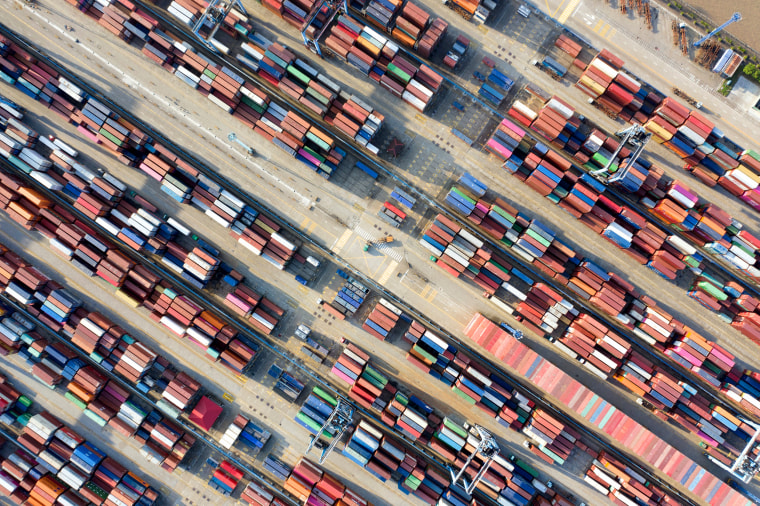President Donald Trump boasted that a first-quarter drop in China’s trade surplus with the United States is evidence that his tariff agenda is working — but recent data paints a more complicated picture, one that trade experts say reveals the unintended consequences of trade sanctions.
"Tariffs are a beautiful thing,” Trump said on CNBC’s "Squawk Box" on Monday. The experts beg to differ.
“The tariffs are leading to weakness in the Chinese economy. This isn’t the way to win a trade war, but that’s how Trump is going to spin it,” said Monica de Bolle, a senior fellow at the Peterson Institute for International Economics.
The U.S. Commerce Department said the trade deficit with China fell in the first quarter by $22.9 billion to $80.8 billion. Commerce Secretary Wilbur Ross tweeted on Friday that this 22 percent drop was “demonstrating how @RealDonaldTrump’s trade policies are giving #AmericanWorkers a fighting chance despite China’s aggressive policies.”
International trade economists say this misses the point. April’s numbers, in the same report as the one Ross cited — although he didn’t call attention to them — show that the China trade deficit increased by $2.1 billion, to $29.4 billion, that month. Chinese data on trade announced Monday also painted a more nuanced picture: The country’s exports rose more than expected in the month of May — and imports sank, yielding a trade surplus of $41.7 billion, roughly double what analysts polled by Reuters predicted.
These seemingly conflicting data sets illustrate the limitations of using bilateral trade data to interpret the complex movement of goods through multinational supply chains. “A lot is made of the trade flow figures. They really should be downplayed rather than emphasized,” said Dan Ikenson, director of the Center for Trade Policy Studies at the Cato Institute.
Ikenson said a primary reason for the complexity behind seemingly straightforward trade data is that the entire value of a product is counted towards the export value of the country where final assembly takes place — even if much of the actual value of the finished product was added in an intermediary country. If a company shifts final production of goods from China to another country to avoid tariffs, the entire value of that product gets counted towards that other country’s export totals, regardless of how much of the finished product’s value was contributed by China.
“You’re just getting rearranging of trade,” said David Dollar, a senior fellow at the Brookings Institution. “This is a disruption for China, but it’s not as serious as the U.S. administration thinks.”
For instance, the unexpected surge in Chinese exports in the U.S. could indicate that corporate America is trying to hedge against the prospect of more tariffs in the future, said Peter Petri, professor of International Finance in the Brandeis International Business School. “That’s probably because American businesses are very scared and they’re stockpiling, essentially, Chinese goods. One of the real obvious signs that you see in these data is that there’s a huge amount of uncertainty,” he said. “That’s always very bad for business,” he said, since it ties up operating capital and curtails investment.
“Using these tariffs as protectionism isn’t necessarily going to affect the trade balance in a predictable way,” Dollar said.
Economists do say that China’s economy has been more seriously impacted than that of the United States by the trade war. China’s $18 billion decrease in imports for the month of May could be evidence of this, de Bolle said. “That’s usually a sign of demand weakness.”
“We’re winning,” President Trump asserted on CNBC, characterizing the prospect of 25 percent tariffs on all Chinese imports as “the best deal we can have.”
It is unsurprising that the Trump administration is couching this as a win, de Bolle said, but it is short-sighted. “He can say his policies have been by and large successful, although what’s really going on is a Chinese economy slowing down that might undermine the entire global economy down the road, including the U.S.,” she said.
Ikenson said shrinking trade volume overall indicates that these effects are already beginning to take place. “There’s a decline in trade between both countries. Overall, the numbers are down,” he said. “I wouldn’t say that’s something we should be celebrating.”
